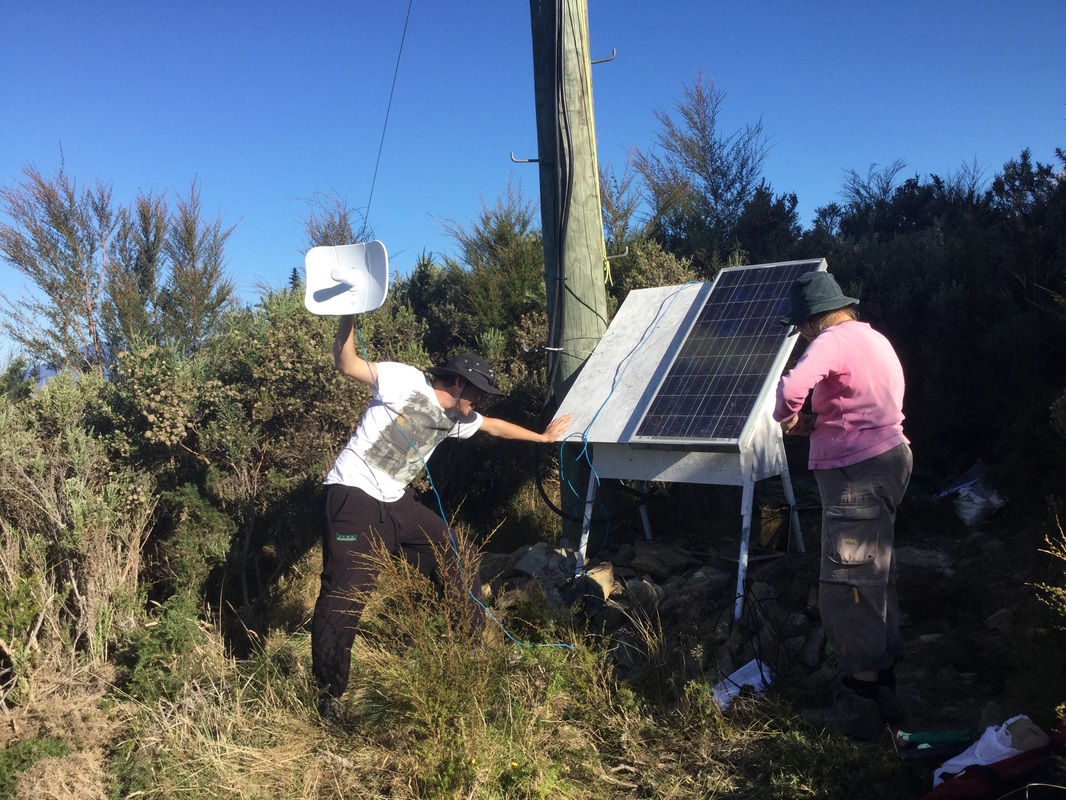|
At times I help out a community WISP providing internet to families in the Kenepuru and Pelorus Sounds. Because of several new WISP trying to operate in the sounds, new repeater stations have been showing up at several sites that where already in use. This has raised the noise floor significantly and has put a big strain on the limited frequency available for amatuer use. Commercial WISP are not required to use a licensed frequency. The community WISP uses only Mikrotik antennas, and there are some limitations when you are trying to find out possible sources of interference. First of all, when you run the spectrum analyser no data will be able to go through the system, causing a short internet outage. Second problem is that If the equipment is not familiar with the wireless protocols used by the unknown wireless sources it won't show up in the site survey. Since Ubuiqiti equipment has become very popular by these new WISP the Sounds community wanted to install a small Ubuiqiti antenna to run a spectrum analyser without causing an internet outage and see wireless signals that use Ubiquiti's AirMax AC protocol. Because of my experience, they asked for my help choosing the hardware, installing and adding it to their existing network. At the same time they would install a new antenna at the repeater site to create a redundant WiFi link. For the antenna I chose a LBE‑5AC‑23 (LiteBeam AC). It will only be used for scanning so this was one of the most affordable options. The repeater is at a remote hilltop without vehicle access completely to the top. It has a very steep climb to the top which takes quite a bit of effort when carrying equipment, tools, mac book and plenty of water. The antenna was connected through a Mikrotik RB260GSP switch, which I will write some more about further on. The nice thing, if a device shows up in site survey with a signal strength, and even better a device name referencing the used hardware, is that with a little bit of effort you can calculate the TX signal strength they use, and then the total EIRP. This can help to find out if these unknown signals operate within the legal limits. Reverse Engineering Transmit Power from Signal StrengthRequirements:
Example: TX gain: 25dBi Distance: 15.8km Frequency: 5.680ghz RX Gain: 23dBi RX power: -81dBm Calculations
Learning MikrotikAlthough my primary role was to help set up the Ubiquiti antenna, when problems arose setting up the new Mikrotik antenna and creating a redundant wireless link I offered my services. This provided a good opportunity to look deeper in WinBox and using TelNet. A complete lack of network diagrams and limited documentation made it difficult to create a picture of their current system. But by asking the right questions, slowly the puzzle came together, and in a few hours the two links where working. By setting different priorities for the two links it will send only data over one, and when it falls over it automatically uses the back up link. The only downside is if you leave the second antenna active and on standby is that it still takes up precious bandwidth on the already very busy spectrum. RB260GSP Switch trouble shooting In the evening the network started to have very short internet outages. The next morning this would happen every 4 to 20 minutes. So what was causing this? Because the systems was stable before, and the only place equipment had changed was the repeater station we worked at, I decided to check the hardware. The Litebeam antenna showed an uptime of only 3 minutes. So that was rebooting, probably meaning a loss of POE. Logging into the switch gives you an option to check the voltage of the power source of the switch. In this case the battery voltage of the system it is connected to. This showed a voltage of 11.8V for a 12V system. So the batteries where low. But Mikrotik advertises it as a switch with an input voltage between 8v and 30v. So theoretically it should work. Turns out after a quick google search we are not the first to see this happening.
The survey has been turned off to save power. It doesn't need to be on continuously. I don't know if they will keep the switch or if they will be looking into installing a more stable device. Their repeater station was never designed for the amount of equipment they have installed over the last few years. With the excess amount of equipment, and winter on the doorstep, it will need a upgrade to their power source very soon. I recommended as a short-term solution to at least update their solar panel. Currently they have an 80 Watt panel and a wind generator. The best thing would be to have a look at all the equipment that is there now, and calculate the energy usage and calculate the new required battery capacity and charging capacity.
5 Comments
|
AuthorGeorge Timmermans, Research Toolmaker, Software Engineer and Tinkerer Archives
March 2024
Categories |
Proudly powered by Weebly


 RSS Feed
RSS Feed